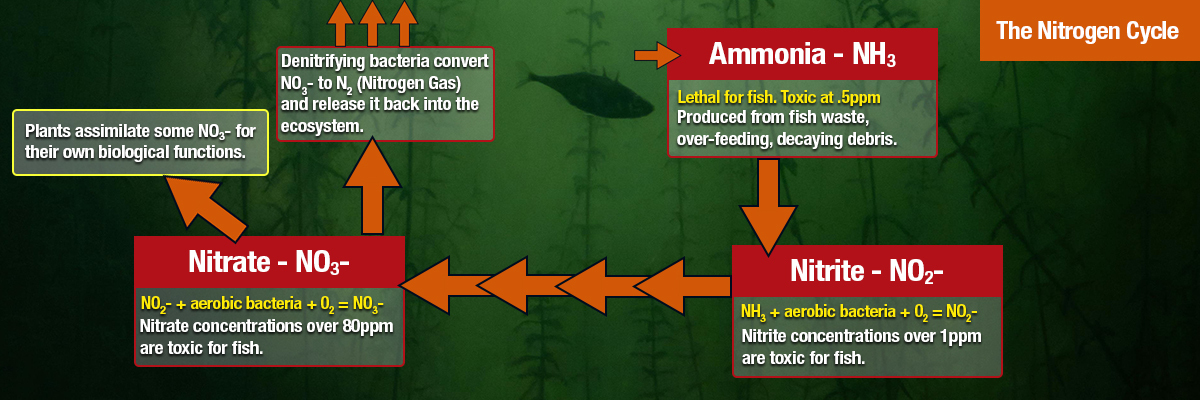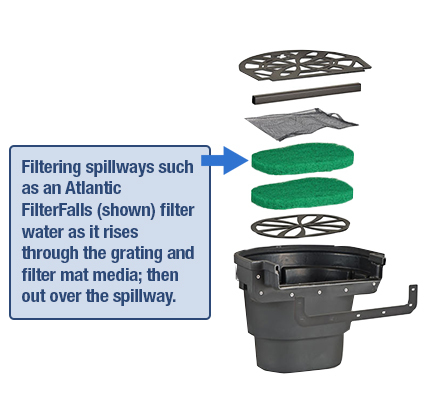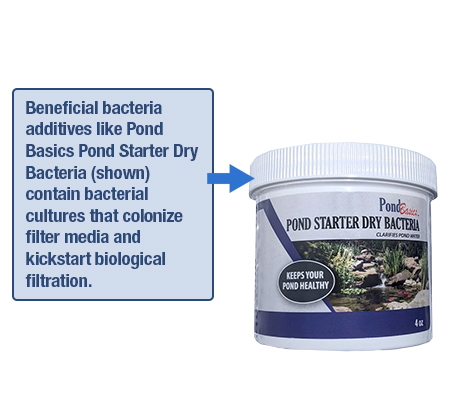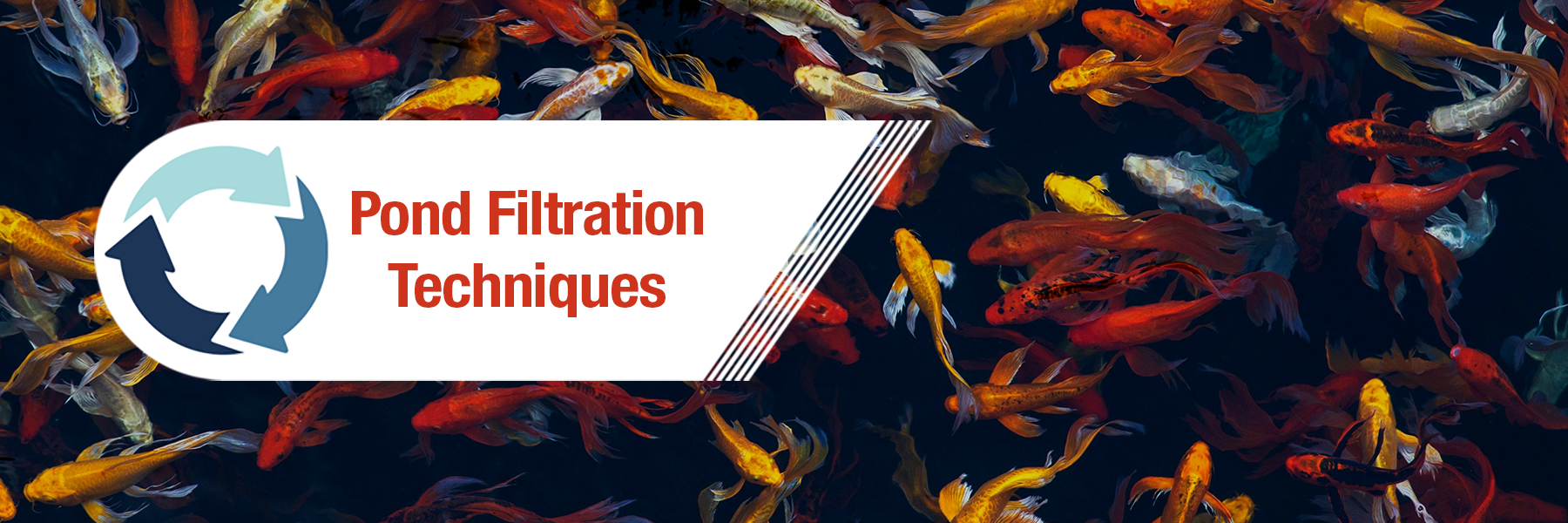Pond Filtration Techniques For Koi And Goldfish Ponds
When considering pond filtration techniques for koi and goldfish ponds we divide pond filtration into three types (by function) biological, mechanical, and plant-based. Each filtration type has its own job to perform but having a combination of all three, working as a system, is the best solution for keeping pond water clean, clear, and healthy. Several filtration tools we discuss can perform two or more functions when installed and maintained properly.
Let's dive in and learn more about these types of backyard pond filtration!
Biological Filtration
Biological Filtration is the action of good bacteria built up in the filtration system to break down, or oxidize, the fish waste, which is primarily ammonia. This allows the ammonia, that is suspended in the water, to be converted into less toxic forms of nitrogen. Ammonia can be very lethal in a koi or goldfish pond.
A Biological Filter is basically a container or area where we place a material or media that has a lot of surface area, such as lava rock, filter pads, BioCubes, gravel, etc. Bacteria will attach itself to the media and multiply if there are enough nutrients, temperatures are warm enough (50 to 55 degrees) and there is enough oxygen. Then we pump/circulate the pond water through the container or area over and over again. This process of biological filtration, also illustrated as part of the Nitrogen Cycle (see diagram), involves several different types or strains of bacteria.

Certain strains of bacteria break down ammonia into Nitrites, which is less toxic than ammonia. Other strains of bacteria break down nitrites converting them into Nitrates. And yet, a multitude of other strains of bacteria and enzymes break down organic matter like leaves and plant debris.
Pond Filters For Biological Filtration
- FilterFalls box
- Bio-Tec ScreenMatic
- Filtoclear Pressurized Filter
- Lava Rock Filter for small ponds and features
- Bog Filter
- Filter Media Varieties (The more surface area the better. Follow manufacturer recommendations for color and density)
- White, Green, Black, Lime colored filter mat
- Matala Filter Material in black, green, blue, or gray
- Bio-cubes in a media bag
- Lava Rock

Seeding your pond with beneficial bacteria is easy with additives such as:
- Nitrifying Bacteria Plus - add weekly for 4 weeks in Spring when pond water temperature reaches 55F.
- Pond Starter Dry Bacteria - add weekly, bi-weekly, or monthly to maintain the full potential of your biological filter. Some manufacturers may suggest adding additives monthly, but in our opinion, making it a weekly habit reduces the risk of forgetting to add it at the "right time." Split your monthly dose into weekly sizes.
- Fall & Spring Pond Treatment - add regularly during the fall and spring when water temperatures are still cool.
- Sludge & Muck B-Gone - add regularly to reduce sludge and debris at the bottom of the pond.
- You may also be interested in an Automated Dosing System. These automatically apply additives to your pond water for you; exchanging the regular routine of adding treatments to simply changing the pouch or bottle when it's empty!

Tech Tip: Biological filters (the physical media containing benefical bacteria) should generally be cleaned only one time per year. It takes 15 to 60 days for the filter to cycle or in other words, to mature completely. Cleaning this filter can destroy the biological filtering ability. If cleaning is absolutely needed due to some unforeseen problem or accident, use pond water only and be careful not to destroy all of the bacteria. After cleaning, you may want to re-seed with Nitrifying Bacteria Plus.
Mechanical Filtration
Mechanical Filtration is the action of removing suspended particles and undissolved organics like leaves, debris, algae and other solids that may get into your pond water from the wind and rain. Mechanical Filtration catches this debris before it is pulled into the pump and clogs it. Make sure to clean the mechanical filter on a regular basis. Depending on the time of the year and the environment in and around the pond, cleaning the filter monthly may be enough during late summer. In the spring, with a flowering tree nearby, you may need to clean the mechanical filter daily.
- Mechanical filters can be a pre-filter cage or sponge on the intake of the pump, a lava rock filter at the bottom of the pond that houses a pump, a pump bag (pump defender) or a pond skimmer.
- Mechanical filter media can consist of a screen, a net or a filter mat that collects the debris as the pond water is pulled through it by the pump. The Filter Mat and Matala Filter Material come in different densities. Some have a more open weave to allow smaller particles to flow through them which allows for cleaning less often. The denser filter materials such as the lime green Filter Mat and the Grey Matala Filter Material are very tight woven and should be checked and cleaned daily if you have a lot of suspended particles in the pond water.
- Some mechanical filters are part of the biological filters, such as Pressurized filters* and ScreenMatic*. These filters will pull out smaller debris and need to be back flushed regularly. The pumps used with these filters generally still need a mechanical filter to catch larger particles.
Tech Tip: Some filters function both mechanically and biologically. In smaller ponds, a lava rock or pump defender filter will provide both types of filtration. When cleaning leaves and debris from these filters, use pond water, not chlorinated water, and do not let them dry out. Remember to use care not to destroy the good beneficial bacteria growing on them. After cleaning, you may want to re-seed with nitrifying bacteria.
Plant Filtration
Plant Filtration is essentially the use of Aquatic Plants to absorb or use ammonia, nitrites, nitrates and other substances as food. Some Aquatic Plants also assist in the removal or neutralization of toxins in the water. Aquatics plants are generally broken in several groups. Each group having many varieties. Some varieties are very invasive and have been prohibited from sale in Ohio. The latest to be banned is Water Lettuce (Pistia stratiotes).
- While some plants like hornwort (seaweed type plant) are sunk to the bottom with weights, some pond plants sit on ledges in shallow water, while others float on the surface with its roots dangling just below.
- A bog garden is a prime example of natural filtration. Read the “Benefits of a Bog” to learn more.
- Just like the different types of filtration, there are different types of aquatic plants that share the responsibility of keeping your pond water clean, clear and healthy.
- Submersible pond plants such as Hornwort consumes nutrients and toxic waste from the bottom of the pond. This plant is weighted so it stays on the bottom of pond. As water flows around this plant, it acts like a magnet attracting suspended nutrients and particles. This plant is considered hardy in our area but does not always survive winter.
- Marginal pond plants are found in nature along the edges of lakes and streams. Some varieties will grow in water up to 8” to 12” deep. Other varieties only like there roots in the water. There are many hardy varieties such as many forms of Irises, a couple species of For-get-me Nots, etc., etc. The more circulation of the pond water through and around the root system of these plants the better job they can do. It should be noted that there are both tropical and hardy marginal pond plants, so check the tag.
- Floating pond plants such as Water Hyacinth helps to reduce ammonia and phosphates suspended in the water. Water Hyacinth are tropical and will not survive a typical winter in Ohio.
- Water Lilies and Lotus do a great job of shading your pond and keeping it cooler. It can also help protect your fish from predators such as heron and hawks. But probably the biggest reason I see for having water lilies and maybe a lotus is the beauty that they add to the pond! Lilies and lotus come in many varieties, colors and sizes. There are hardy and tropical varieties. There reds, yellows, pinks, lavenders, blues, color changing and more.
NOTICE: Never dispose of or release pond plants or pond fish into natural lake bodies, canals, or waterways as their introduction can potentially cause environmental damage.
The combination of these filter that are sized and maintained properly, with the adequate number of plants has produced fantastic results. Happy Pondering!!!
